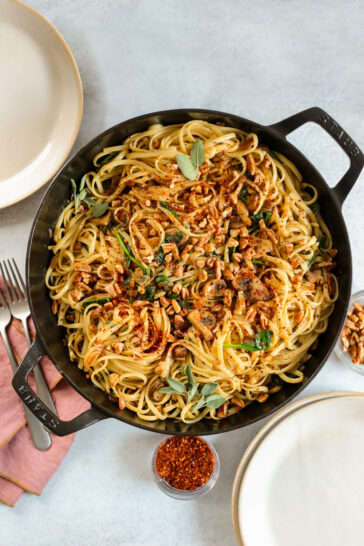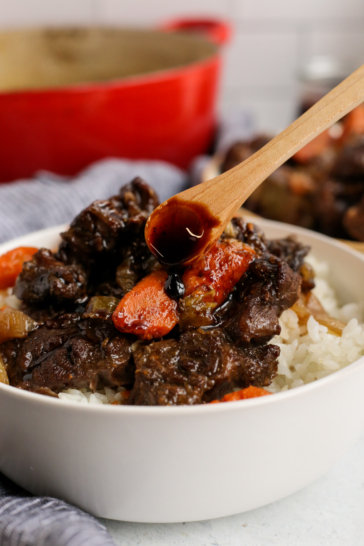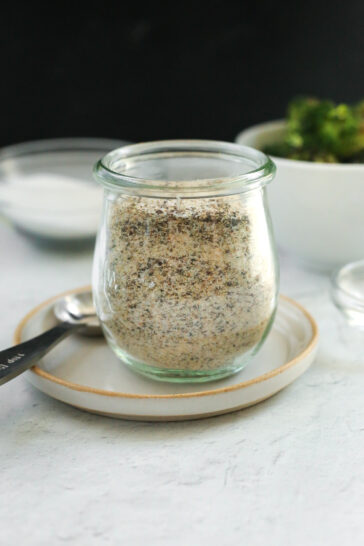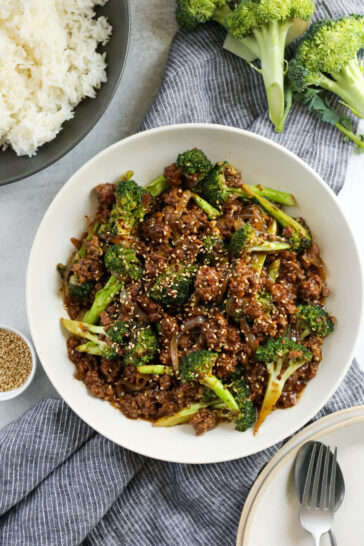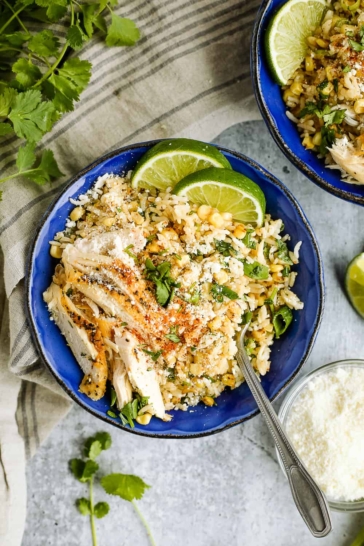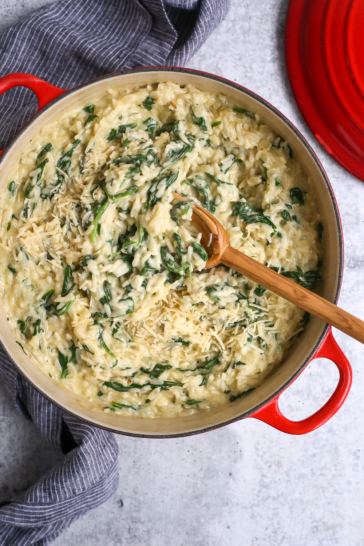Simple meal planning can go a long way towards easing stress in the kitchen! As an anti-diet registered dietitian, I’ve got plenty of experience helping people plan ahead for meals, snacks, and more without enforcing rigid food rules or diets. Keep reading for some of my best tips to simplify meal planning using gentle nutrition and a non-diet approach.
Welcome to the Intuitive Eating FAQ Series! This is where I answer some of the most frequently asked questions about intuitive eating and a non-diet approach. This post focuses on simple meal planning, using a gentle nutrition approach without food rules or dieting. Here’s our reader-submitted question:
QUESTION: I need some help – my busy schedule is hectic enough as it is, and I think planning some meals would ease some stress. But whenever I look for tips on getting started, the meal plans are all designed for weight loss. I don’t want to go back to following food rules, and weight loss isn’t my goal. I just want to make it simple in the kitchen! How can I make meal planning work without turning it into another diet?
I hear you loud and clear! One of the most significant revelations in my journey with intuitive eating was finally separating a meal plan (noun) with meal planning (verb). Instead of rigid food rules to live and die by, meal planning became a form of self-care that made life less chaotic.
What I’ll Cover In This Post

Meal planning can also help you come up with more reliable meal ideas, reduce food waste, and help you stick to a food budget if you’re watching your spending. And, if you’re cooking for other family members, it can create some predictability. No one wants to scramble last minute to get a meal on the table, and no one wants an argument about what you’re going to serve!
If you want to read more about the benefits of meal planning, check out this post: What You Need to Know About Meal Planning & Intuitive Eating.
So you’re right, there’s lots of ways simple meal planning can help. Even if weight loss isn’t your thing, it can help with other nutrition goals or managing a health condition. Personally, I find it helpful to focus on things like more fiber from whole grains, limiting added sodium, or using fresh ingredients when they’re in season.
If you’re ready to get started, keep reading!

Getting Started with Simple Meal Planning
There’s no hard-and-fast rules about what meal planning looks like. In fact, I find that for most people, having some flexible structure allows for the freedom to accommodate whatever life throws at you. It’s a great way to set an intention for how and what you’ll eat for the week. But also leaves room for that unexpected dinner invite, more leftovers than you anticipated, or a schedule change that interrupts your regular routine.
Think About Your Lifestyle
First, try to think about how meals fit into your current lifestyle or routine. This helps you get clarity on not only your goals and expectations for how meal planning can help. It also helps you see how you can make it a sustainable behavior change.
For example, think about your schedule and when you will have the opportunity to go to the grocery store, prep food, and clean up afterwards. This sounds like such a simple strategy, but you’d be surprised how often it isn’t accounted for! So many meal plans assume you’ll make your shopping list on the weekend. And that you’ll show, prep, cook, and clean so by Sunday night you have enough meals to get you to the end of the week.
But here are just a few reasons to form your own simple meal planning routine:
- You can go grocery shopping more than once a week…or less often than once a week.
- You’re the one that knows your schedule best. If you work long hours, irregular shifts, or work as part of the gig economy, the standard meal plans might not account for the variability.
- If you have plans for eating out, traveling, or other things in the coming week, you can more easily work around that.
- You don’t have to plan an entire week’s worth of meals at once. You can forecast for just a few days. Or, eliminate some decisions by having a theme for a certain night of the week.
A few themes include Pasta Night, Salad Night, Stir Fry Night, Clear-Out-The-Fridge Night, or Grilling Night. You can try new recipes, stick to old favorites, or wing it by using ingredients that need to get used up.
Think About Your Taste Preferences
It’s also important to consider your taste preferences and favorite flavors. Be sure to include those so you can have meals you genuinely enjoy! One major frustration with meal plans is they often include ingredients or flavor you don’t love…I’m thinking specifically about pickles and olives in my case!
The next step is to think about how you prefer to cook. Do you like following a recipe line-by-line? Or would you rather take liberties to make it your own? Do you want hands-off cooking methods like with the crock pot or sheet pans? Do you have a lot of time to cook, or not much at all? And would you rather prep ingredients, make ready-to-eat meals or an assortment of meal components to mix & match depending on your mood or appetite?
There’s no right or wrong answers here, so take some time to think it over. And be honest! Only you know what you need from this simple meal planning process. And know that it’s OK to try something and switch it up later if it just isn’t working for you.
Should you make a meal plan in advance?
Traditionally, most meal plans are broken down into weekly plans. Which is fine…if that works for you. Like I mentioned above, that 7-day period is subject to change. Especially if it feels intimidating or overwhelming to come up with your next 21 meals + snacks all at once (more on that in the next section).
If you’re new to non-diet meal planning, try tackling a shorter amount of time. One week can be a good starting point, but try four days. Or two days. Even one day! In my experience, clients sometimes prefer shorter versions of meal planning to allow for variety.
Variety helps reduce boredom, giving you novelty and satisfaction. But there’s a tradeoff: this can also be time-intensive. As a solution, you might try creating 3-5 versions of a one-week meal plan and cycle or rotate through them. This might take a lot of time initially, but will certainly save you time and effort later.
Here’s a graphic that illustrates what a one-week template might look like:
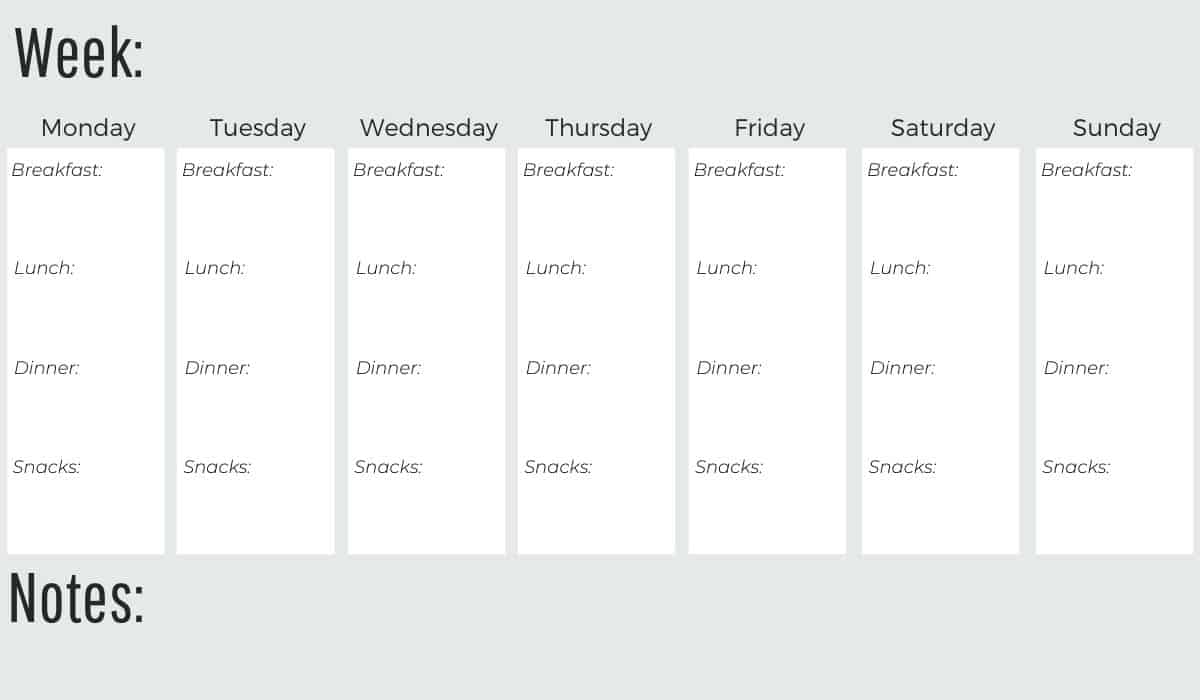
When you’re writing out or thinking about your non-diet meal plan, honor your food preferences, appetite, and individual needs. You can also account for your unique schedule and work in gentle nutrition.
So yes, you can tackle all 21 meals plus snack at once. But read on, and you’ll see why maybe you don’t have to do all that!
How do you plan meals for the week?
I like to use an approach that works backward to account for the meals I know I don’t have to plan for. This simple meal planning strategy might work for you, too. Especially if you value flexibility and want to have more options beyond cooking each meal from scratch.
For example, if I know we are going to order takeout on Friday night, I cross out that block from my meal planning calendar. If I know a recipe will have enough for leftovers, I can also block out lunch the following day. This helps reduce the total number of meals I have to actually cook. Thus, it reduces the overwhelming feeling of thinking about how big of a task it is.
Another strategy is planning specific meals, versus an entire day. For example, if family meals are the focus, plan breakfasts and dinners, leaving flexible options for lunch. Or if you know that lunch is the greatest challenge, use a short-list of favorite recipes for dinner. You can focus on preparing lunches when your time and energy are less available.

Recipe Inspiration and Meal Ideas
If you need some new ideas, there’s plenty of places to find simple meals and healthy recipes! If you’re here on the Street Smart Nutrition blog, you already know food blogs are a great place to start.
However, here’s a few things to keep in mind for a non-diet approach:
- Many food bloggers include health claims or nutrition facts about their recipes that aren’t necessarily accurate or correct. Terms like, “clean” or “keto” have little meaning these days but work well for showing up in search results because that’s what our culture associates with “healthy meals”. Try to ignore or avoid these as much as possible if you find them triggering.
- The nutrition facts information and calorie counts are rarely reliable. The tools used by most food bloggers pull from a database that doesn’t include all forms of certain foods, leading to variability between what is actually being used, and how it’s calculated towards the totals. Also, certain brands will vary. And you might want to make your own adjustments to the quantities called for in the recipe. Don’t feel beholden to stick to a recipe right away or include everything listed.
- If a yield or serving size is suggested, remember that it’s just that: a suggestion. If your appetite calls for a larger or smaller portion, use that as your guide vs. sticking to exactly what an online recipe calls for. You know your appetite best, and you don’t have to serve yourself the same amount every time!
Beyond food blogs, you can find inspiration from cookbooks and restaurant menus. Some people even love watching reality TV like cooking competitions to recreate unique dishes in their own way at home.
My best advice: don’t get overwhelmed by too many options. Set aside a few favorite cookbooks or subscribe to one or two of your favorite food blogs. This ensures you have a steady stream of inspiration for a week of meals without getting bogged down by too many options. Create a master list of 5-8 recipes that, when all else fails, will fill you up and nourish you (and your entire family) in a pinch.
What are some other ways to plan meals?
Making a “meal plan” is, in its simplest form, just a way of putting some intentional forethought into what you’ll eat in the future. Some people like to plan based on what ingredients they already have, or around a special event (birthday, anniversary, etc.) on their calendar. Some people like to plan 100% of their meals and snacks, down to every detail.
Others plan parts of their meals and leave room for flexibility (such as, the same base recipe but a different sauce or dressing each time you have leftovers).
There are many ways to go about this, and again, it depends on your kitchen and budget. In my experience, there are pros and cons to all of them. There’s nothing wrong with some trial and error to find the approach that works best for you.
For example, you might plan to batch cook larger quantities of certain ingredients. When it comes time to eat, you just reheat and serve. Batch cooking requires more assembly time during reheating/eating, but offers much more variety in how you mix and match ingredients. If you get bored easily, you may favor this strategy versus fully pre-assembled meals that are identical to one another.
I used that approach with this Salmon Salad recipe. The base recipe is the same, but there’s at least three different ways to eat it during the week. Depending on the other ingredients I have or what I’m in the mood for, no effort or food is wasted. And I never end up bored!
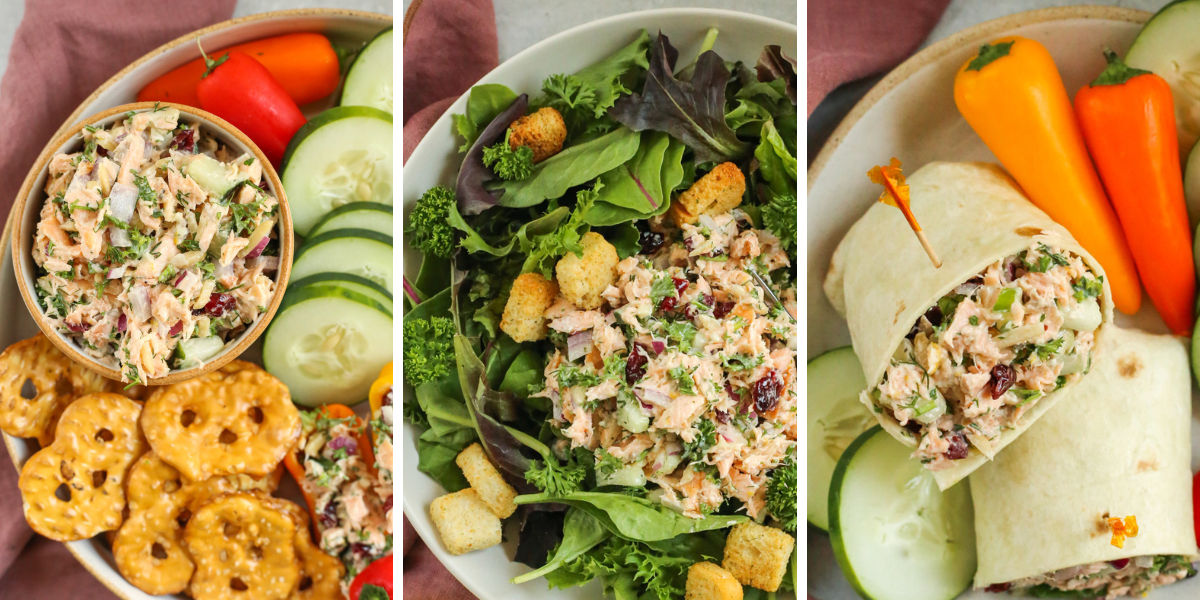
That being said, if you like predictability and routine (and don’t mind eating the same thing each day), that option might make sense. It takes larger time commitment upfront. But once your meals are assembled, there’s no thinking required when you’re ready to reheat and eat.
Are there any shortcuts for simple meal planning?
Of course! Like anything else in the kitchen, I think there are lots of ways to cut corners when you need to.
One of my favorite shortcuts is to rely on some convenience foods for certain meals. For example, I usually keep some frozen meals and cans of soup on hand for the days when my meal planning either didn’t line up with my schedule, or I want something other than what I prepped. This shortcut saves time (and usually money) because you can still enjoy a meal at home and avoid wasting food.
I also recommend taking advantage of freezer space if you have it available. Many prepared foods freeze well. If you can tackle a large batch of cooking at once, you can stock your freezer with meals or ingredients that take little effort to thaw and reheat.
To save time, you can try a grocery delivery service like Instacart. Or place an order from a specific grocery store and use their pickup or curbside service. You can even save a grocery list to repeat in the future. Having a well-stocked pantry makes simple meal planning that much easier.
Don’t forget to stock up on the right tools for meal prepping! Check out my Cooking Resources page to see some of the products I rely on and recommend.
And again, don’t forget about the option to plan for dining out. That’s still putting forethought into what you’ll eat in the future! Jut, with the added convenience of no time needed for cooking or clean up. Granted, that might be pricier for your budget. But if that’s a tradeoff you’re willing to make, you can absolutely rely on that whenever you need or want to.
Finally, there are options like meal kits that tackle the shopping and some of the ingredient prep for you. During especially busy weeks, or when I get back from traveling, I turn to options like Blue Apron or something similar. It just makes everything simple, even if it does require a little planning in advance. You can read more about my experience with meal kits HERE. They can offer an alternative to planning and prepping every meal yourself if that’s something you need or want!
So there you have it! Some of my best, tried-and-true tips for simple meal planning with a non-diet approach.
And if you’re ready to start saving some dinner ideas, check out these recipes. They are tried-and-true when it comes to meal prep. They store and re-heat like a dream!
- Three-Bean Lamb Chili for the Stovetop or Slow Cooker
- Homemade Cheesy Tuna Noodle Casserole
- Great Northern Bean Soup with Barley
- One-Pan Rotisserie Chicken Fried Rice (which tastes best with leftover rice!)
Disclosure: This post was originally published in January 2021. It has a since been updated to improve the overall quality of the information and/or images.

